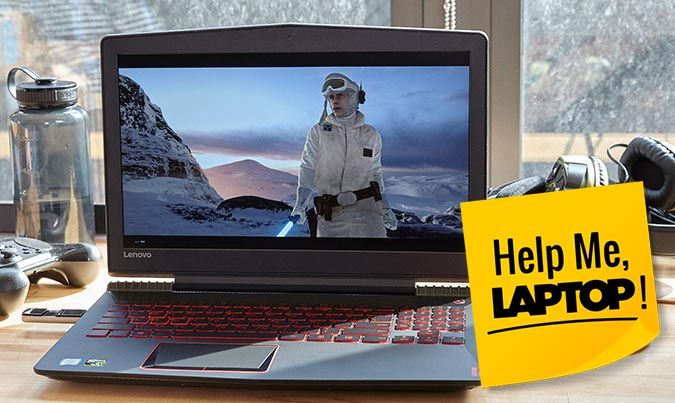Help Me, Laptop: Which Gaming Notebook Should I Buy?
With all the great laptops on the market, finding the one with the perfect configuration, design and price for you can be a hassle. Forum member kaiowolf is in the midst of such a dilemma, struggling to choose between the Asus ROG Strix GL753VE and the Lenovo Legion Y520. Luckily, we've reviewed both laptops and can provide a little insight.

In terms of design, I prefer the Y520's more subtle approach to the GL753's neon-orange accents. While I'm typically appreciative of any gaming laptop that isn't black and red, the GL753's fluorescent orange is too much. But that's just me. The Asus does get a few brownie points for its programmable, customizable, backlit keyboard, while Lenovo continues to take a more monochrome approach, with red backlighting.
Anyhow, on to the display. The Strix has the better screen by far, at least when it comes to color reproduction and brightness. The Asus laptop's 17-inch display hit 124 percent of the sRGB gamut, with a brightness of 285 nits. Compare that to the 15-inch Lenovo, which notched 68 percent and 220 nits. The Legion evens things up a bit on the color-accuracy test, scoring 0.2 to the Asus' 2.2.
The systems have nearly identical specs. Each one features a 2.8-GHz Intel Core i7-7700HQ processor with 16GB of RAM and a Nvidia GeForce GTX 1050 Ti GPU with 4GB of RAM. However, with a 256GB PCIe SSD and a 2TB 5,400-rpm hard drive, the Legion has twice the storage of the Strix (256GB SSD; 1TB 5,400-rpm hard drive). That gives the Lenovo an advantage when storing larger games, like Mass Effect: Andromeda, which requires at least 55GB of space.
When we ran some of our synthetic benchmarks, the Legion asserted its dominance, hitting 46 frames per second on the Rise of the Tomb Raider test (1080p, Very High settings), compared to the Asus, which notched 29 fps. The Legion was also one of the few sub-$1,000 gaming rigs that could run the graphically taxing Metro: Last Light at a passable frame rate of 31 fps. The Strix wasn't too far behind, at 28 fps, but a couple of frames per second can mean the difference between a stuttering mess and a smooth run-and-gun experience.
The Legion also performed well on our overall performance benchmarks, achieving 13,037 on Geekbench 4, which topps the GL753's showing of 12,394. On the File Transfer test, the Lenovo outpaced the Asus, at 363.5 megabytes per second to 221.3MBps. The laptops tied on the OpenOffice Spreadsheet test, at 3 minutes and 19 seconds, where they were tasked with matching 20,000 names and addresses.
One of the few places the Strix managed to best the Legion was in battery life. The Asus lasted through 5 hours and 25 minutes of continuous web surfing over Wi-Fi, while the Lenovo tapped out at 3:39.
Stay in the know with Laptop Mag
Get our in-depth reviews, helpful tips, great deals, and the biggest news stories delivered to your inbox.
Overall, I recommend that kaiowolf go with the Lenovo Legion Y520. For $1,158, you get a gaming laptop that's surprisingly powerful as far as budget gaming systems go. At 15.6-inches, it's also far more portable than the 17.3-inch Asus ROG Strix GL753VE (priced at $1,268). However, if you're looking for a laptop with a bigger screen, flashier design and longer battery life, you might want to consider the Strix. But in terms of sheer performance, it's no contest.
Laptop Guide
- Laptop Buying Guide: 8 Essential Tips
- The Best & Worst Laptop Brands
- Laptop Tech Support Showdown: Undercover Report
- Should I Buy a Chromebook? Buying Guide and Advice
- Laptops with the Longest Battery Life
- Chromebooks vs. Windows 10 Laptops: What Should You Buy?
- Why You Shouldn't Buy a Touch-Screen Laptop
- Out of the Box Tips: Set Up Your New Laptop Like a Pro
- The Best Time to Buy a Laptop
- Chromebook vs. Tablet: Which Should You Buy?
- Laptop Buying Tips for Students
- 10 Key Features to Look for in Your Laptop
- How to Buy a 2-in-1 Laptop Hybrid
- USB Type-C FAQ: Everything You Need to Know
- How to Get Rid of Your Old Laptop
- Laptop Warranties: What They Cover
- Which CPU is Right For You?
- Which Laptop Features Are Worth the Money?
- Gaming Laptop Buying Guide: Find the Right Rig
- 10 Reasons Why Consumers Should Buy Business Laptops
- Which MacBook is Right for You?
- 5 Things to Look For in Your Next Laptop Keyboard
- How to Configure Your Laptop: Specs That Matter
- Which Graphics Card Do You Need?
- The Perfect Laptop? Here’s What It Should Have
- Why 78 Percent of Laptop Screens Suck
- A Guide to Computer Ports and Adapters
- 13 Ways to Make a Slow Laptop Faster
- How to Tell If You Can Upgrade Your Laptop
- Laptop Locks Guide: Do You Need One?
- 10 Features You Can Skip to Save Money

Sherri L. Smith has been cranking out product reviews for Laptopmag.com since 2011. In that time, she's reviewed more than her share of laptops, tablets, smartphones and everything in between. The resident gamer and audio junkie, Sherri was previously a managing editor for Black Web 2.0 and contributed to BET.Com and Popgadget.
